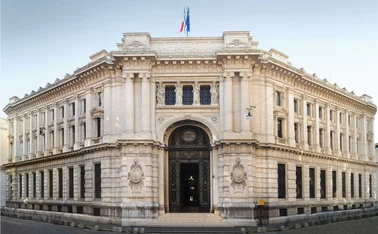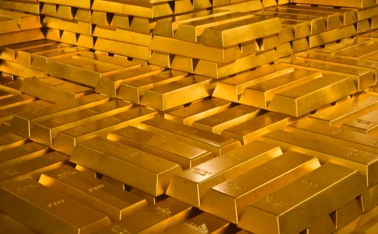
Has Covid-19 made gold shine brighter?

We are living in uncertain times. Over the course of 2020, policy-makers worldwide have watched international travel restrictions and local lockdowns imposed, entire sectors close and stock markets fall and then rise at an alarming rate. The financial crisis that began in 2007–08 no longer seems a once-in-a-century event.
It therefore comes as no surprise that central bank reserve managers have scrambled to optimise their portfolios during the pandemic. In the past, central banks have turned to gold – universally known as the safe-haven asset. The precious metal has helped central banks tame the impact of negative sovereign bond yields and has acted as a source of value against deflation. It has also helped central banks reduce currency concentration within their portfolios.
During the Covid‑19 pandemic, central banks have aggressively cut interest rates and dramatically expanded their asset purchase programmes. This has supported expansionary fiscal policies, but also contributed to further depressing sovereign-bond yields. As a result, longer-term US Treasury yields have fallen to negative levels and the entire German bund yield is now below 0%. Against this background, gold has rarely appeared more attractive.
During Central Banking’s National Asset-Liability Management Conference in October 2020, diversification appeared the biggest driver of central banks’ interest in gold. In real and nominal terms, gold has outperformed many other asset classes since the end of Bretton Woods.
Amid the turmoil brought about by Covid-19, investors globally have increased their exposure to gold. This has boosted prices in 2020 by 26% to $1,925 per ounce on October 12. Nonetheless, central banks’ net purchases have decreased this year in comparison with previous years. Central bank net purchases totalled 233 tonnes in the first half of 2020 – 39% below the levels recorded during the same period in 2019, according to the World Gold Council.
However, this mostly reflects that the first half of 2019 recorded the highest level of net purchases since 2000. In fact, central bank gold purchases in the first six months of 2020 were only 6% below the period average of 247.1 tonnes since 2010, when central banks became net purchasers on an annual basis.
One important factor putting downward pressure on overall gold demand is that some central banks are using their resources to honour their mandates. “During a major crisis, gold is there for you to sell – especially if your country lacks foreign exchange reserves,” Robert Rekasi, head of FX reserve management at the Central Bank of Hungary, told Central Banking.
According to the World Gold Council, price fluctuations at the start of the year were also due to investors liquidating their gold to raise cash to cover losses in other asset classes. Similar trends were witnessed during the financial crisis, but gold still managed to be one of the few asset classes to post positive returns at the time.
This trend is likely to continue in the months ahead. In August, central banks became net gold sellers for the first time in approximately 18 months. Overall, central banks sold a net 12.3 tonnes during the month. Purchases were concentrated in a small group of regular buyers. The Kyrgyz Republic bought 5 tonnes, India 4 tonnes, Turkey 3.9 tonnes, the United Arab Emirates 2.4 tonnes, Qatar 1.6 tonnes, Mongolia and Kazakhstan, 1.3 tonnes each.
However, these operations were offset by the sales of a single central bank. Uzbekistan reduced its gold reserves by almost 32 tonnes in August.
Historical volatility
Since the financial crisis, gold recorded sharp price movements that asked questions of its position as a stable investment asset during periods of financial volatility. As the US economy consolidated its recovery in 2013, and the Federal Reserve hinted it was planning to withdraw part of its post-crisis stimulus, the gold price started to decline.
By December 2015, the gold price had fallen from $1,700 per ounce to $1,050, at which time the Fed implemented its first rate hike in almost a decade. Despite the price volatility, European central banks, such as those of Hungary, Poland, Russia and Turkey, alongside China, have boosted gold purchases over the past decade.
In the second quarter of this year, Turkey remained the largest gold buyer, according to the World Gold Council. The central bank’s net purchases reached 97.8 tonnes, accounting for 85% of global purchases during the period. The central bank’s gold holdings now stand at 606 tonnes, still behind the levels held by major European central banks, such as France (2,436 tonnes), Italy (2,451 tonnes) and Germany (3,362 tonnes). Covid-19, which threatens to quash growth for the forseeable future, has arguably made gold more attractive to central banks using it to hedge against swings in exchange rates and inflation.
Nonetheless, the sustainability of recent price increases remains uncertain. The Fed’s new policy framework is one factor that could impact the long-term price of gold. In August, the US central bank adopted average inflation targeting, saying it will temporarily allow inflation to increase over the 2% target. This means interest rates in the US are likely to stay lower for longer.
On September 16, in its first policy announcement after unveiling the new policy framework, the Fed signalled the federal funds rate would remain close to zero through 2023.The Fed’s unwillingness to hike could be worrisome if, in the aftermath of the Covid-19 crisis, the US and international economies experienced stagflation. In that context, there might have been some doubt as to whether the Fed would tighten fast enough, contributing to investor uncertainty.
There is the possibility gold could behave very much as it did in the stagflation of the 1970s. In an environment of low growth, high unemployment and inflation, gold was boosted by investors seeking refuge. In 1971, gold traded at $35 per ounce but, by the end of the decade, it touched $850 per ounce – a 2,300% increase.
Political landscape
Historically, gold has been used by central banks to reduce currency concentration within their portfolios – specifically for the US dollar. As gold portfolios grew larger, US dollar foreign reserve currency allocations declined from 65.4% in 2016 to 60.9% in 2019.
The sharp fall in dollar liquidity at the height of the pandemic in March and April saw investors and official institutions focus their efforts on securing access to the world’s reserve currency. In a dollar-centric monetary system, gold’s attractiveness rests on the ability it offers its holders to access dollars. But this traditional role for gold may be about to lose importance.
As part of the set of measures the Fed unveiled in March to improve international dollar access, it created a new facility allowing, for the first time, foreign central banks to access dollars posting Treasuries as collateral. The Fima repo facility, as it is known, allows account holders at the New York Fed to enter into repurchase agreements with the Fed; this line provides central banks with an alternative and secure way of accessing dollar cash other than selling their gold reserves.
For countries facing US financial sanctions, gold remains an attractive alternative. Russia is the prime example of this – after illegally annexing Crimea from Ukraine in 2014 and occupying the east of the country, Barack Obama’s administration imposed hefty economic sanctions on Vladimir Putin’s regime.
In a bid to limit the effectiveness of these sanctions, Moscow has sharply reduced its US treasury holdings while rapidly boosting gold holdings. In July 2020, Russia’s holdings of US Treasuries were recorded at just $5.9 billion. In January 2013, Russia held $164.4 billion in US treasuries.
From 2013 to 2019, Russia’s net gold purchases reached 1,313 tonnes – 187.6 tonnes per year, on average – according to the World Gold Council. So far this year, Russia’s net purchases have amounted to 28.2 tonnes. These operations have more than doubled Russia’s gold reserves to 2,299 tonnes in October 2020.
However, this strategy seems to have run its course. The Central Bank of Russia surprised the market when it announced the suspension of its gold-buying programme from April 1. In a statement, the central bank gave no reason for the decision, but has hinted in the past it may scale down its gold purchases.
“Further decisions on buying gold will be made depending on the development of the situation in the financial market,” the central bank said in its statement. In 2019, the Central Bank of Russia announced it would purchase domestic gold at a discount. As a result, buying slowed to an annual rate of 158.1 tonnes, almost 25% lower than the previous four years.
The future is uncertain
The unprecedented economic shock created by Covid‑19 creates an uncertain outlook that also affects gold. Midway through the year, there were signs normality was returning: travel restrictions were eased at home and abroad, people were encouraged to return to work, and positive case numbers across Asia and Europe fell. However, recent weeks have shown complacency is a risky gamble.
New domestic lockdown measures are being imposed across Europe, and the US is unlikely to reopen its borders this year. Continued market instability and growing uncertainty about the future shape of the global economy is likely to be at the forefront of central bankers’ minds. Amid sharp GDP falls, negative bond yields, growing tensions between the US and China, and a protracted global health crisis, only one thing seems certain: gold will continue offering shelter to investors.
This feature forms part of the Central Banking focus report, Gold for central banking 2020
Further reading
Only users who have a paid subscription or are part of a corporate subscription are able to print or copy content.
To access these options, along with all other subscription benefits, please contact info@centralbanking.com or view our subscription options here: subscriptions.centralbanking.com/subscribe
You are currently unable to print this content. Please contact info@centralbanking.com to find out more.
You are currently unable to copy this content. Please contact info@centralbanking.com to find out more.
Copyright Infopro Digital Limited. All rights reserved.
As outlined in our terms and conditions, https://www.infopro-digital.com/terms-and-conditions/subscriptions/ (point 2.4), printing is limited to a single copy.
If you would like to purchase additional rights please email info@centralbanking.com test test test
Copyright Infopro Digital Limited. All rights reserved.
You may share this content using our article tools. As outlined in our terms and conditions, https://www.infopro-digital.com/terms-and-conditions/subscriptions/ (clause 2.4), an Authorised User may only make one copy of the materials for their own personal use. You must also comply with the restrictions in clause 2.5.
If you would like to purchase additional rights please email info@centralbanking.com test test test





